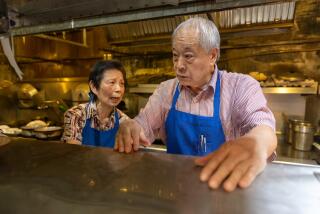Chinese Food To Go Is Common : China’s Sichuan Province Has Take-Out Chefs
- Share via
CHENGDU, China — Take-out Chinese food is common around the world. But only in China’s Sichuan Province do you find take-out Chinese chefs.
The export trade in chefs is the responsibility of Chen Kehao, 42, a well-fed official who specializes in sending Sichuan chefs to restaurants around the globe, wherever there is a demand for the 20-centuries-old peppery fare from southwestern China.
“There is more and more demand for my chefs,” said Chen, whose cooks are already assembling spicy dishes in 23 countries, including the United States.
Why?
“Because Sichuanese cooking has a lot of taste,” Chen declared at his Chengdu headquarters. “Its color, its smell is very good.”
Local Chinese will even tell you that “Sichuan dishes can cure heart disease,” he said. “After you eat hot peppers your heart beats very fast,” he laughed.
The chubby chefmeister is quick to add that Sichuan-style cooking need not be so hot it numbs the mouth. It can be sour, sweet, a bit of each, he said. It can even taste “strange.”
Sichuan Moves Up
And it takes in all foods--fish, poultry, meat, vegetables, even something as bland as bean curd, or tofu.
“In the past, in foreign countries, usually the Cantonese dishes would be the most part of business. Now, there are more and more Sichuanese dishes,” he boasted.
Cantonese food hails from Guangdong Province in southeast China, and is what is found in most Chinese restaurants in Europe and the United States.
Five of Chen’s finest chefs work at the Sichuan Restaurant on 45th Street in New York, near the United Nations, he said. Two more are in nearby New Jersey. Four are in Washington, D.C.
To keep things authentic, the chefs come equipped with herbs and spices from their mountainous province, which, aside from its food, is renowned as the home of China’s pandas.
Chen’s biggest headache is securing visas for his exported chefs.
There used to be 14 chefs in New York before immigration officials, fearing an onslaught of culinary defections, slapped on limits, Chen said.
“Maybe we should invite some immigration leaders to a Sichuan restaurant,” he said, hoping the Chinese tradition of maintaining strong personal relationships with business contacts might help.
Austria-Sichuan Partnership
Chen’s chefs are also found in West Germany, Japan, Australia, Nepal, Hungary, France and even Peru.
One will go to work shortly in Vienna, where Sichuan Province and the Austrian government are partners in a restaurant to be built in the Narrow River Park section of the city, Chen said.
Chen is general manager of the China Sichuan Corporation for International Techno-Economic Cooperation, or SIETCO, which holds 70% of the Viennese restaurant partnership.
He said Sichuan got into the restaurant business 10 years ago with the advent of China’s policy of opening to the West.
“American Chinese people came to us and told us that many foreigners like Chinese food,” Chen said. “They told us to come.”
His chefs cannot be rented, but come as part of a package deal in which SIETCO and a foreign partner set up a joint venture to own and operate a Sichuan restaurant.
The chefs train at special schools for three years before serving an apprenticeship of up to 10 years in Sichuan Province. They are usually younger than 40 when they leave home to work abroad for up to four years.
Undisclosed Ratio
They are paid the prevailing wage wherever they work. They send most of it back to China, where it is split in an undisclosed ratio by SIETCO and the chef’s family.
Chen would not say how much money the province makes on its restaurants. But he did grumble that “profit is not very high.”
Not to worry. Chen has a sideline.
When not swinging woks for foreigners, SIETCO’s 20,000 employees can be found in the construction business. They will, for instance, build the Sichuan restaurant in Vienna.
They’ve already built a Chinese-style acupuncture center in Spain, a sports arena and sanitation center in Kenya, roads in Somalia and Uganda and 17 bridges in Nepal.
More to Read
Eat your way across L.A.
Get our weekly Tasting Notes newsletter for reviews, news and more.
You may occasionally receive promotional content from the Los Angeles Times.









